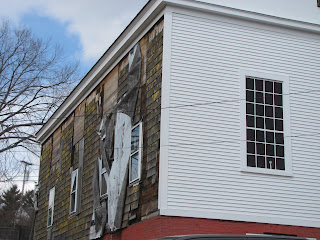My first historical site visit was to the Abyssinian Meeting House in Portland, Maine, located at 73-75 Newbury Street. The early March day was chilly, and it took a while to find the site, which is tucked into an urban neighborhood of one way streets and multifamily apartment buildings. Surprisingly, two other people stopped by to check out the building; whether they were curious to see what my husband and I were gawking at, or they just happened by at the same time, I couldn't tell. Still, it was nice to see others taking an interest in it.
The Abyssinian Meeting House was not open. It is currently undergoing a total restoration by The Committee to Restore the Abyssinian Meeting House, so we had to content ourselves with reading the information on the building and reading the plaque in the sidewalk (after getting down and blowing off a winter's worth of road sand from it!). The Department of the Interior entered the building into the National Register of Historic Places in 2006.
The meeting house is part of the Portland Freedom Trail, which marks sixteen sites in Portland associated with people, places or events connected to the Underground Railroad and the abolitionist movement. The Abyssinian, according to the plaque, had the distinction of being the first black church in Maine. It opened in 1828 and is the third oldest black church still standing in the U.S. The meeting house was mostly financed by African American Reuben Ruby, who waited tables and then opened his own hack stand (horse drawn taxi stand) in Portland. Other blacks helped finance the building, which was erected by free blacks. The original impetus for building was to have a place for black people to worship where they weren't treated as second class citizens (they were relegated to the worst parts of churches, the uppermost levels and the very back).
The Abyssinian Congregational Church was the heart of the African American community in Portland, and served many purposes. Opening in 1828 in the middle of the second Great Awakening (1790-1860), it was a hot spot for meetings and discussions of reform issues of the day, including temperance, education and abolition. It was a church, a place for Bible classes, sewing circles, a school and was a stop on the Underground Railroad. It drew important and influential abolitionist speakers, including William Lloyd Garrison and Frederick Douglass, who educated and challenged the public to fight for the rights of blacks. Runaway slaves also spoke there about their first hand experiences, due partly to the efforts of the Reverend Amos Freeman, the Abyssinian's first full time minister and an Underground Railroad agent. Other ministers over the years at the Abyssinian were also outspoken abolitionists.
The proximity of the Abyssinian to Portland's docks also made it easier for escaped slaves to make their way there, with the help of many of Portland's free blacks. Blacks held positions that were of low visibility (dock workers, mariners, hack drivers, etc.), but which had strong social connections that enabled them to move people along the route to freedom.
One of the Abyssinian's distinctions was that it survived the devastating Portland fire of 1866, which destroyed more than 1,500 buildings. Because of the quick thinking and efforts of William Ruby, a firefighter and Reuben Ruby's son, the building continued to serve the black community until it closed and was sold in 1917.
After undergoing significant structural changes, including being made into a tenement apartment building, the meeting house was purchased for historic preservation in 1998. The building had a long, important history in Portland and a large role in helping many escaped slaves make it to freedom in Canada and overseas. The restoration will help educate the public about Portland's black cultural, social, educational and religious history, and about the Abyssinian's larger role in the social reform movements in American history.
Sources consulted for information included:
http://www.abyme.com/
http://www.portlandfreedomtrail.org/
Excerpts from Maine's Visible Black History on Blackboard
http://en.wikipedia.org/wiki/Abyssinian_Meeting_House
Class notes from HTY 360, History of Maine



